#plesioth posting
Text
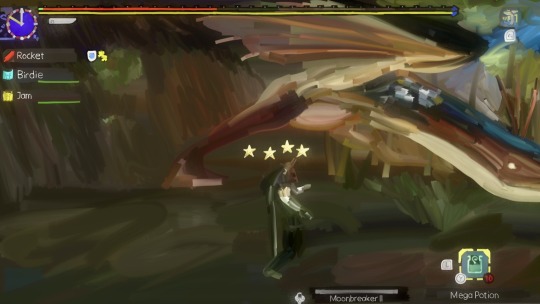
I Am Going To Need A Fucking Miracle, 2024
Digital acrylic on canvas
Immortalizing a lucky hunter's fateful moment versus the G Rank Hyper Plesioth hip check.
121 notes
·
View notes
Text
youtube
To date one of my hardest and most longest Monster Hunter fights yet!
3 notes
·
View notes
Text
Round 3 Matchups
After a quick detour to work out how ties will be handled, it's time for Round 3 to begin! As decided here, Nightcloak Malfestio and Nergigante will move on to a 1v1v1 in this round. Voting will begin on the 16th, and this post will be updated with links to each matchup down below. As always, may the best monster win, and happy voting!
Fatalis Vs. Raging Brachydios
Black Diablos Vs. Narwa the Allmother
Royal Ludroth Vs. Ivory Lagiacrus
Kulve Taroth Vs. Dalamadur
Bazelgeuse Vs. Chameleos
Astalos Vs. Amatsu
Flaming Espinas Vs. Tobi-Kadachi
Pukei-Pukei Vs. Savage Deviljho
Gigginox Vs. Dodogama
Nakarkos Vs. Banbaro
Plesioth Vs. Deviljho
Frostfang Barioth Vs. Molten Tigrex
Dah'ren Mohran Vs. Silverwind Nargacuga
Tigrex Vs. Hellblade Glavenus
Jhen Mohran Vs. Lunastra
Namielle Vs. Malzeno
Crimson Qurupeco Vs. Thunderlord Zinogre
Seregios Vs. Lao-Shan Lung
Somnacanth Vs. Stygian Zinogre
Odogaron Vs. Gogmazios
Scorned Magnamalo Vs. Espinas
Glavenus Vs. Ceadeus
Alatreon Vs. Gore Magala
Nightcloak Malfestio Vs. Nergigante Vs. Silver Rathalos
Abyssal Lagiacrus Vs. Ahtal-Ka
Xeno'jiiva Vs. Velkhana
Qurupeco Vs. Thunder Serpent Narwa
Malfestio Vs. Elderfrost Gammoth
Boltreaver Astalos Vs. Mizutsune
Garangolm Vs. Goss Harag
Lagiacrus Vs. Chaotic Gore Magala
Shen Gaoren Vs. Shagaru Magala
5 notes
·
View notes
Text
Wyvere Reviews All the Monster Hunter Monsters (Assorted Monsters)
So, you might be confused by this title here. Well, some of the classes in Monster Hunter are given a pitiful amount of monsters compared to others. Which forces me to shove them all into one post rather than dedicate multiple posts to them. Anyway, let's give these classes the love they deserve!
Wingdrakes

Our first class today will be the Wingdrakes. From my understanding, they're classified by being small, pterosaur-like wyverns. Barnos is our first of the five, and they're pretty decent as far as dragons go. The wings have some... interesting anatomy, though. 6.5/10
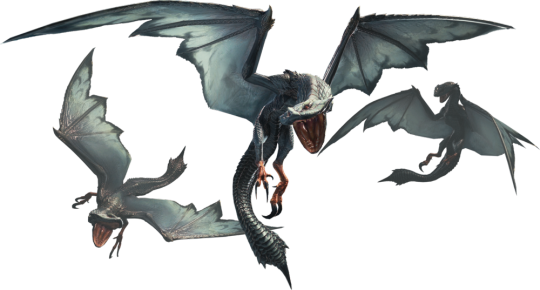
Cortos have a wonderful snakey vibe with their faces, and overall are probably my favorites of the Wingdrakes (though it's not like they have a lot of competition). 7.5/10

Mernos remind me almost of some Bird Wyvern designs with their weird hammer shaped heads. I kinda theorize that they are related to some of the monsters there, but are classified as Wingdrakes since they're comparatively small. 7/10
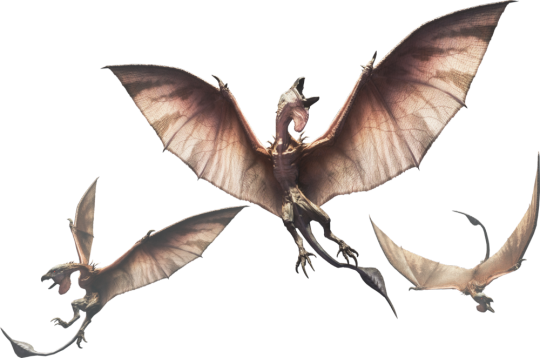
Oof, Noios are... unpleasant to look at. I know it might have been the intention, but the birds they were probably based on, turkeys and vultures, look pleasant compared to them! Also, that is some awful anatomy with the chest. 3/10
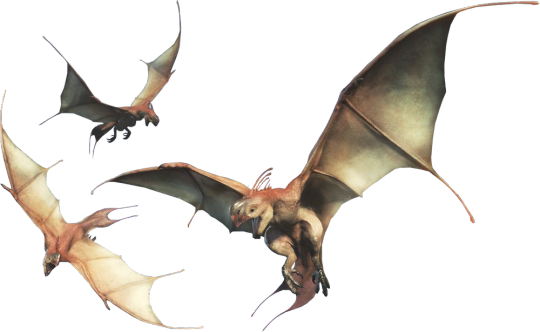
At least we have the absolutely adorable Raphinos! These parrot-like monsters are also included in the monsters I want to hug. 7/10
Piscine Wyverns

The Piscine Wyverns are wyverns that resemble bony fish, though Cephadrome also has a cool Diplocaulus head with their fins and fin-like wings. 7/10

Plesioth is also pretty cool, with an almost shark-like head to go with the traits of bony fish. 7/10
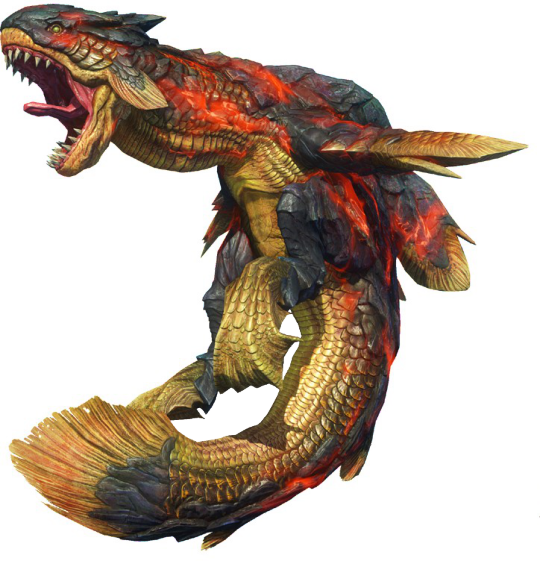
But Lavasioth is even cooler (not literally), with some lava coating on their scales and a coelacanth-esque design! Coelacanths are wildly underused as monster designs in media, and a lava coelacanth is just such a cool concept. 7.5/10

Delex have traits of dolphins, but also some lovely gharial faces! Gharials are so cool, they need more love... 7/10

Gajau aren't as weird, but still cool, as they're catfish with traits of sturgeons. Catfish are pretty aggressive in real life, so this is pretty accurate. 7/10

Jyuratodus is another coelacanth, this time associated with mud. Unfortunately, they aren't exactly the most nice on the eyes, and compared to a lava coelacanth, a mud coelacanth is kinda boring. 6/10

Beotodus is pretty cool (literally)! They also have some coelacanth traits, and on top of that, they have a naga-esque nose horn! A weird, but fun combination, 7.5/10!
Amphibians
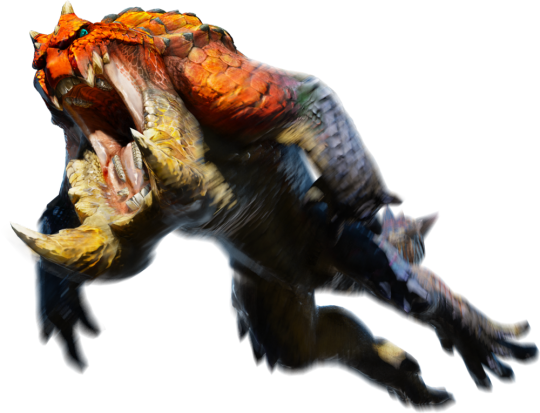
Next up are the Amphibians, which there are... only three species of. That's way too little! I love dragons, don't get me wrong, but we need more frog monsters, damn it! Tetsucabra is probably the froggiest of the frogs, but they still have giant tusks and traits from Dunkleosteus! A super cool frog, 7.5/10.
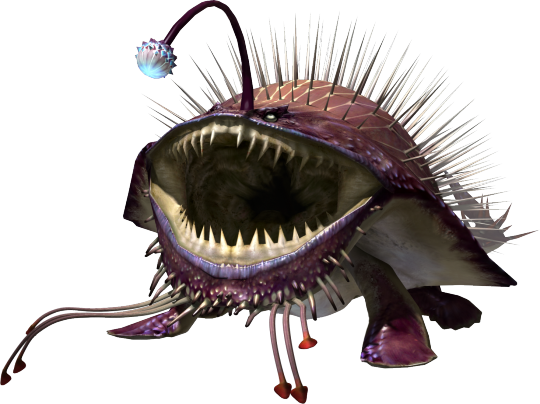
"Wait, isn't Gobul a Leviathan?" you may be asking if you play Monster Hunter. "Why are they here?" Well, partially because they look more like a frog, and partially because there are a ton more Leviathans than several of these classes combined, so I needed to pad this out. Gobul works better as an Amphibian too, and is a pretty cool design overall. We need more deepsea monsters too! An Elder Dragon based on a deep sea fish would be cool... 7.5/10


Zamtrios is a shark frog that can cover themselves in ice. Both nakey Zamtrios and armored Zamtrios are cool, so I got renders for both. They can also inflate themselves like a balloon, for some reason. A pretty weird monster, but also a pretty cool one. 7.5/10
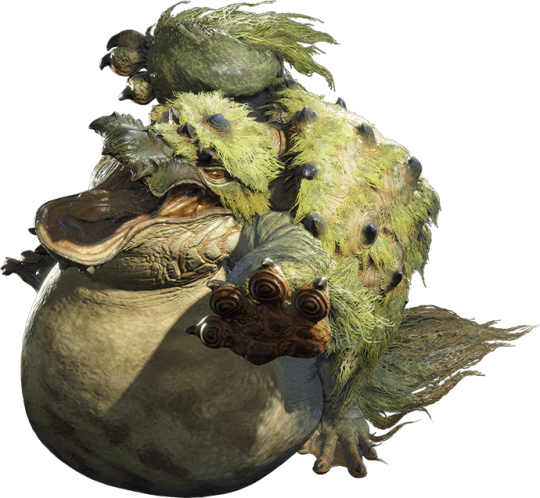
Tetranadon is a platypus frog, and sadly, our last Amphibian. At least they're a pretty cool monster, though! They even have some traits of the mythological Kappa, with the turtle shell on their back and moss growing on their body like hair! I still wish we had more amphibians, though... 7.5/10
Snake Wyverns
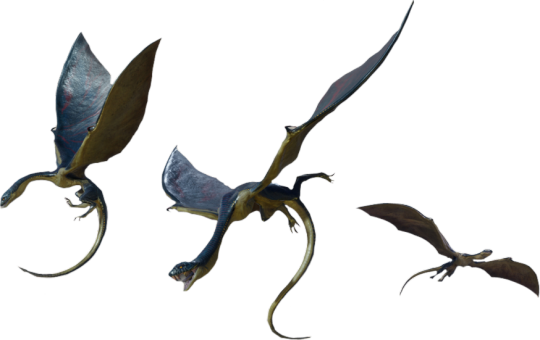
If the Amphibians were done dirty with only three major species plus some subspecies (and a Leviathan I have included with them), the Snake Wyverns were done goddamn tarnished, with a measly two species and one subspecies! That is way, way too little! When the next Monster Hunter game hits, I demand we get more snakes! ...Anyway, the Remobra are pretty neat, with nice snakey faces and slender bodies. 7/10

Najarala, however, is one of the coolest damn monsters in the series, with some really unique looking ans awesome scales, which kinda remind me of Quetzalcoatl with how they look almost like feathers. Again, why there are so few Snake Wyverns when they can be this awesome, I have no clue. 8.5/10
2 notes
·
View notes
Text
@plesioths replied to your post “what's up gamers it's been so long since I've...”:
Orange Orange Orange
ORANGE!!!
#plesioths#replies#my favorite color since forever and therefore the best color for characters to have
0 notes
Text
An excerpt from the zoological text The Hunter’s Encyclopedia of Animals (First Edition).
Chapter VI: Plesioth
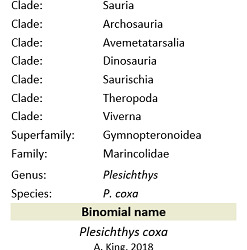
The plesioth (Plesichthys coxa) is a species of pelagic wyvern found off intertropic coasts across the globe. At a weight of 4.7 tons and a length averaging 26 meters, it contends for the title of largest marine predator. The plesioth’s physiology is adapted to a life spent transitioning between land and water — it is capable of diving to depths of 450 meters at speeds of 54 km/h (34 mph), and remaining submerged for 40 minutes at a time. The plesioth’s ability to fly was forfeited early in its evolutionary history, replaced by adaptations that allow it to withstand extreme deep-sea pressure and low concentrations of dissolved O2. Its vestigial wings, meanwhile, underwent exaptation and have been jury-rigged into fin-like appendages that assist in swimming. According to one study, the plesioth’s lifespan is approximately 50 years.
The plesioth has few natural predators as a result of its venomous spines. Laterally-visible, horizontal orange stripes advertise the neurotoxin to any potential predators. Every so often, juveniles are susceptible to predation by sympatric predatory megafauna. In addition to its aposematic coloration, the plesioth can ward off predators by forcefully ejecting a fluid from a pair of glandular sacs inside its mouth. This liquid projectile can be accurately sprayed as far as 5 meters (16 feet). The fluid is miscible in water, and therefore exclusively used on land. Both of the aforementioned adaptations are utilized as antipredator mechanisms and have no function in hunting. Rather, the plesioth is an ambush predator that kills its prey through a combination of stunning (tail-slaps, high-velocity breaches) and drowning. Countershading obliterates its outline in the water, with its dark dorsal scales making it inconspicuous to animals looking down on it from above. The bulk of its diet is comprised of fish, and as the plesioth matures it begins to incorporate larger prey species such as pinnipeds, pseudophids, and ornithischians. Because of the plesioth’s moderate fecundity and wide distribution, its conservation status is classified as least concern.
The plesioth has a recurring presence in the cultures of seafaring people. Although it doesn’t actively hunt humans or wyverians, plesioths have been known to follow ships at a distance. They scavenge on bycatch and waste jettisoned from vessels, and occasionally raid nets and fishing lines for an easy meal. As a consequence of conditioning them to associate boats with food, plesioths are the most likely culprits of attacks on shipwreck victims. Their ghostly white, translucent third eyelids, in conjunction with their habit of congregating near sunken ships, may have influenced the myth of plesioths being psychopomps. A number of equatorial communities honor the plesioth through week-long ceremonies and parties. Such festivals are accompanied by the custom of mounting a plesioth’s skull or severed head on an ornately-carved pole, not unlike a Mari Lwyd. Anthropologists speculate that a misunderstanding led to the belief that the mounted head was actually a hammer. Traditional dishes include a ceviche marinated in citrus, and rotten flesh fermented in lactic acid. In medicine, the plesioth’s venom has potential as an anesthetic and a pharmaceutical drug for treating insomnia.
Other names for the plesioth include the plesio, water wyvern, and shark wyvern. The latter is a title it shares with the cephadrome (Selacharena alata) and anorupatisu (Pristocephale glaciesecans).
The plesioth’s name is an example of semantic drift. The word is originally derived from the clade Plesiosauroidea, a group of long-necked marine reptiles. Plesiosaurus is a compound of the Greek words plēsíon “near” and saûros “lizard,” and refers to the group’s resemblance to limbed squamates. Over time, the prefix plesio- was recontextualized to have the meaning “like or similar to a plesiosaur.” Thus, the plesioth was named for its resemblance to plesiosaurs, and was assigned the suffix -ioth to maintain the naming convention already established in the common names of other animals (like the lavasioth and epioth). Ironically, the genus Plesichthys is a portmanteau of plēsíon and ikhthús “fish,” and was named for the plesioth’s near fish-like appearance.
Taxonomy and evolution
Fossil evidence suggests that the plesioth evolved from a unique lineage of diving wyverns 10 million years ago. Unlike other vivernans of that period, the plesioth’s ancestor Marincola marincola [†] was semiaquatic, roosting in small colonies on seaside bluffs. Its streamlined body reduced drag when plunging from flight, allowing it to hit the water at breakneck speeds exceeding 80 km/h (50 mph). Air sacs in the face and chest cushioned the impact, a feature which was later lost in its descendant (along with skeletal pneumaticity). The ancestral plesioth moved underwater via foot propulsion, with the wings used for steering. Today P. coxa primarily swims using a combination of its webbed feet and an undulatory locomotion reminiscent of BCF (body-caudal fin) swimming. A comparison of the foot morphology between the holotype M. marincola and modern gannets supports the diving → swimming transition theory, and proposes a convergence amongst semiaquatic theropods.
While the plesioth shares a common ancestor with flying wyverns, it has a long history of genetic independence from its closest relatives (raths, khezus, and other vivernans). Molecular systemic DNA research places the plesioth in a basal lineage of gymnopteronoid.
Subspecies
There are only 2 extant representatives of the family Marincolidae. Each subspecies is characterized by scale coloration, distribution, circadian rhythms, and preference for hunting techniques.
The oil-backed plesioth, or informally simplified to oil-back (P. c. coxa), is the nominate subspecies. Its range encompasses the subtropic and tropic coastlines of the West Dragon and East Dragon Oceans, and the interior seas of South Elde: Jyuwadore, Shikuse, and Moga. It inhabits seagrass meadows, kelp forests, coral reefs, and coastal alcoves which have a water temperature between 13°C and 29 °C (56°F and 85°F). Although P. c. coxa is active during the day it is primarily a crepuscular predator, and has greater success at hunting during the hours of dusk and dawn. It gets its name from the appearance of its dark blue scales when seen in clear water with low turbidity; the contrast gives it a resemblance to “an oil spill come to life.”
The green plesioth (P. c. viridis), unlike P. c. coxa, dwells in brackish ecosystems, including wetlands, swamps, and estuaries. They typically avoid venturing out into saltwater, although fishermen have reported seeing them as far as a mile from the nearest coast. It’s generally accepted that the presence of green plesioths in mangrove swamps (near Jumbo Village) and river mouths (like those of the Metape Jungle and Flooded Forest) reduces competition with the oil-back. P. c. viridus takes advantage of its green pigmentation by concealing itself amongst hydrophytic plants such as water lettuce and duckweed. Perhaps because of its greater reliance on camouflage, this diurnal subspecies almost never breaches when hunting.
Characteristics
Physical description
As a member of the clade Viverna, the plesioth’s body plan is largely representative of the wyvern archetype: a bipedal stance and horizontal posture with the tail held parallel to the ground. Where the skeletal structure differs is in the wings. While the thumb in other wyverns is short and supports the leading edge of the wing, all of the plesioth’s metacarpals and phalanges are elongated and involved in supporting the membrane. The pleated patagium can be tucked against the plesioth’s torso while swimming, thereby reducing surface area and contributing to its streamline, hydrodynamic shape. The wings range in color from white to cream, with orange spots on the outer edge of the dactylo- and iliopatagium. The backside of the torso and head are deep blue, while the underbelly features white scales. The ventral and dorsal regions are sharply delineated by lateral orange stripes that run from the conical snout to the tail along the frontal/coronal plane. Imbricate, ovate scales flow down the body in a head-to-tail configuration that allows for a smoother flow of water over the body to reduce drag. Their visual and functional similarity to cycloid scales on teleosts is homoplastic. The feet are totipalmate.
The plesioth partly owes its charismatic appearance to its white red-tipped semifins. The semifins are webbed structures supported by cartilaginous spines, attached to an endoskeletal base with associated muscles for movement. Being cartilaginous makes the semifins flexible and allows them to flare or collapse against the body. They are classified according to location on the body: dorsal, supercaudal, subcaudal, cranial, tarsal, and pseudopercular. The semifins’ spines are the site of venom conduction.
When submerged, the palatal valve at the back of the mouth creates a watertight seal which barricades the esophagus and trachea. This enables the plesioth to seize prey underwater without drowning, although it has to return to land in order to eat. When hunting, its cone-shaped, slightly recurved teeth allow it to tear through small and medium-sized fish. The carinae (edges of the teeth) are finely-serrated with denticles on the front and back, suited for biting prey outside of an exclusively piscivorous diet. The dentary and premaxilla/maxilla hold 36 teeth that are more densely-packed toward the front of the jaw, and that decrease in size toward the back of the mouth. During attacks, the nictitating membrane is drawn across the eye to protect it from abrasions.
The loss of tyrosinase function results in a genetic mutation called amelanism. Colloquially known as seabream plesioths (after fish in the genus Pagellus), individuals with this pigmentation abnormality don’t produce melanin and have white in lieu of their typical aegean coloration. Because the mutation only disrupts melanocytes, the chromatophores responsible for their orange and iridescent properties — erythrophores and iridophores — are still expressed. The continued production of light-reflecting and carotenoid pigments is what gives the seabream plesioth is distinctive white and reddish-orange look.
Venom
In total, the plesioth has 31 spines distributed across its body. They form part of the semifin, which occurs either in symmetric pairs, or along the medial region of the body. Although the semifins are superficially reminiscent of the ray-fins found in actinopterygians, they aren’t homologous. Semifins are classified into 6 categories according to body region, with the following spine distribution: 4 cranial, 8 pesudopercular, 7 dorsal, 4 tarsal, 4 subcaudal, and 4 supercaudal. The largest spines measure at 7’ 4” (2.2 meters) and are more than capable of penetrating the skin of the largest marine animals.
The primary structural element of the spines is cartilage, a supple and elastic tissue comprised of a dense network of collagen fibers embedded in a gelatinous ground substance. Its composition gives the spines tensile strength, enabling them to resist changes in weight and pressure while possessing greater flexibility than bone. Because cartilage is an aneural, avascular tissue, spines cannot be regrown if they’re damaged or removed. A protective integumentary sheath obstructs the opening of the spine. During envenomation, the sheath is pushed back as it enters the attacker. This process compresses the venom gland at the base of the spine, and allows the venom to diffuse into the puncture wound by travelling through shallow grooves in the now-exposed spine.
It’s thought that the semifins originally evolved as accessories for swimming, and that venom acquisition was a supplementary feature. The plesioth’s venom glands produce a subgroup of neurotoxins known as hypnotoxins, a soporific venom that depresses the central nervous system and affects the neurotransmitter gamma-aminobutyric acid (GABA) at the GABAA receptor. Its symptoms are much like the effects of anesthesia, and can be divided into the same 4 stages of the Guedel’s classification: induction, excitement, subconsciousness, and overdose. At Stage 1, the victim progresses from analgesia without amnesia to analgesia with amnesia. It’s entirely possible that the lack of pain — coupled with memory impairment — can lead to the victim’s inability to recall the initial sting and recognize that they are in danger. Stage 2, arguably the most dangerous, is when life-threatening conditions occur, such as delirium, arrhythmia, vomiting, respiratory distress, pupillary dilation, and spastic movements. Species that lack gills can quickly become disoriented after envenomation and drown as a consequence of the respiratory system becoming compromised (through pulmonary aspiration, apnea, et cetera). Stage 3 is the cessation of the previous symptoms and the onset of subconsciousness. Branchial predators become incapable of pursuing the plesioth, while air-breathing predators at this stage are all but 100% guaranteed to drown. Stage 4 is incredibly rare, and usually occurs if the spines puncture the victim for a long enough duration, or if multiple spines are involved in envenomation. Overdose results in brainstem or medullary depression, followed by complete respiratory and cardiovascular arrest. Without medical intervention this stage is always fatal.
Additional health risks posed by envenomation include: pieces of the spine breaking off and embedding themselves in the wound, leading to infection; and anaphylactic reactions to the venom.
Water-spitting
Before the plesioth’s phylogeny was properly understood, a common misconception was that P. coxa had gills and was descended from an unknown clade of branchial tetrapods. Its ability to spit a high-pressure jet of water from its mouth was likened to various species of archerfish. Later studies proved that the plesioth is a theropod, which made the archerfish’s mode of liquid projectile an impossibility as it involves contracting the opercula (gill covers). Dissection and field observations led to the discovery of paired sacs at the back of the mouth. Dubbed the paralingual glands, these poorly-understood organs can expel up to a quart (32 ounces) of liquid at once and possess just enough of the chemical for 10 discharges (2.5 gallons’ worth), before the glands have to produce a new supply over the next fortnight. The expulsion release is controlled by muscles behind the jaws. There is insufficient data as to what the liquid is composed of, but preliminary chemical analysis suggests a high presence of hydrogen and oxygen.
Diving adaptations
Even though the plesioth is most frequently observed inhabiting the photic layer (the uppermost layer of the pelagic zone, 0 m — 200 m), it can also be found within the mesopelagic layer (200 m — 450 m). At these depths, pressure can be greater than 40 times that of the surface. A combination of stressful deep-sea conditions such as high pressure and low oxygen can cause mechanical barotrauma. To eliminate the risks of physical damage like decompression sickness and organ rupture, the plesioth’s bones became depneumatized. The loss of postcranial air-sacs in the skeleton makes the plesioth denser and prevents embolisms (from buildups of dissolved N2) by decreasing the total air volume in the body. Similarly, the presence of air-filled pockets in the skeleton would have increased buoyancy, a trait that would have been disadvantageous to a diving animal.
Enhanced anaerobic capacity and hypoxemic tolerance are essential for facilitating long dives. When submerged at certain depths, the heart rate is reduced to as low as 20 — 30 bpm. Bradycardia occurs when the plesioth exceeds its aerobic dive limit (ADL), at which point tissue perfusion and oxygen uptake are decreased in order to preserve respiratory and blood oxygen stores. Non-essential organs are shut down and muscles are isolated from circulation, which together cut down on oxygen depletion and extend dives for as long as 40 minutes. Hemoglobin in plesioths shows high cooperativity with oxygen, a phenomenon whereby the binding of one molecule of oxygen with hemoglobin facilitates the binding of the next oxygen molecule and so on up to binding four oxygen molecules by one hemoglobin. The degree of cooperativity hemoglobin has is expressed by the Hill coefficient, which is estimated to be well above 4 in P. coxa. High cooperativity increases the efficiency of the oxygen delivery to tissues. Without these traits, the plesioth wouldn’t be able to withstand the extreme demands placed on its respiratory and circulatory systems that would otherwise result in unconsciousness.
To compensate for diminished olfaction and the mesopelagic layer’s low visibility, the plesioth has evolved powerful visual acuity. Its emmetropic eyes possess a flattened cornea that makes the cornea’s refractive power in air and the corneal power loss in water negligible. Roughly 10% of the eyes’ refractive power is contributed by the cornea, unlike in humans, which contribute up to 70%. Instead, the lens performs the majority of the focusing. This feature minimizes the optical effect of submergence. Sharp images above and underwater are formed by plesioths changing the shape of the lens through muscle contractions.
Behavior
Intraspecific interactions
Plesioths do not routinely seek out conspecifics outside of the breeding season. When plesioths do encounter others in the water they tend to ignore each other, though they demonstrate a remarkably high tolerance for each other’s presence. Socialization isn’t unheard of, however; plesioths may engage in cooperative hunting behavior if two or more are pursuing the same target. Juveniles and subadults will sometimes swim in small bands of three as an added precaution against predators.
Hunting and diet
The plesioth is a predominantly piscivorous animal, with 60% of its diet featuring a large diversity of fish species that are obligate shoalers. Despite this, they are not fastidious in their food choice and readily vary their prey selection according to availability, as evidenced by the remains of other animals found in their stomachs and fecal matter. Juveniles are restricted to hunting fish and other small vertebrates, and only begin to diversify their diet around the age of three. Mature adults are slightly more opportunistic, having the required size to take on larger non-fish prey items. A 30-kilo (66 lbs) meal can sustain a plesioth for up to 5 to 9 days before it is required to hunt again. Scavenging on carcasses isn’t overly common, nor is venturing inland to hunt. Plesioths only go after terrestrial prey when it’s near the water’s edge and within striking range. There are three generally-accepted hunting tactics employed by plesioths, with a slight skewing of preference between the subspecies: ambush-drowning, breaching, and tail-slapping.
The preferred method of taking down non-aquatic animals involves the plesioth motionlessly dwelling along the waterfront. The blue (P. c. coxa) and green (P. c. viridis) dorsal coloration is cryptic for each subspecies’ respective habitat. Concealment allows the plesioth to remain undetected long enough for it to ambush prey. Its conical, recurved teeth are suited for preventing prey from escaping once it seizes them in its jaws. The blinding speed with which it strikes gives the plesioth enough time to drag its prey into deeper water, where it then holds it beneath the surface until it succumbs to a combination of exhaustion, blood loss, and oxygen deprivation.
Breaching is a tactic reserved for animals such as epioths, ludroths, and seals, and is almost exclusively seen in P. c. coxa. The oil-back slams into prey from the deeper water below, with the momentum often taking it partially or fully clear of the water (achieving a max height of 10 meters). At speeds of 54 km/h, the g-force behind the impact is sufficient enough to fully stun prey.
The final hunting strategy is a tail-slap deployed either overhead or sideways. A kinematic study of plesioths attacking bait balls found that the tail-slap occurred with such force that it caused dissolved gas to diffuse out of the water column, forming small bubbles. Due to acceleration of waterflow around the leading edge of the tail, turbulent pressure drops below the saturated vapor pressure, causing the aforementioned plume of bubbles. The associated shockwave is powerful enough to immobilize as many as 20 fish in one tail-slap, which cuts down on the energy costs of hunting active prey.
The diet of P. c. coxa includes a wide array of aggregating fish such as pin tuna, speartuna, glutton tuna, Moga tuna (Katsuwonus katsuo), knife mackerels, wanchovies, sardines, and blue cutthroats. Oil-backed plesioths may sometimes take medium-sized sharks (most commonly Centrinis armatus). Epioths (Cetuserpens repandus and Pseudophis nitidus), immature ludroths (Harpaga leo), and island narwhals (Monodon mysticus) are hunted in deeper waters. Qurupecos (Cantio sirenius) that fish along the shore and passing aptonoths (Parasaurolophus cristatus) are known to have been attacked as well.
The diet of P. c. viridis contains a variety of freshwater and euryhaline fish such as gajuas (Palustincola ferox), fen catfish (Palustincola gravis), silverfish, red-finned arowanas (Osteoglossum esculentum), and burst arowanas (Osteoglossum authothysia). The green plesioth’s proximity to biodiverse terrestrial ecosystems allows it to feed on animals such as slagtoths, immature ludroths (Harpaga blattea), otters, bullfangos (Ossispina taurus), epioths (Pseudophis esmeraldus), congas (Flovorator altilis), and assorted frog species.
Enemies and competitors
Very few attacks made on the plesioth are successful, and are only perpetrated by a handful of species. The venom glands are active at birth and even juvenile plesioths are capable of delivering a potent sting to would-be attackers. Nevertheless, there have been a few documented cases of immature plesioths being killed and consumed by sharks and adult ludroths. The remains of adult plesioths found in the digestive systems of lagiacrus (Heres jormungandrii), pliosaurs, and large placoderms suggests that these predators are capable of hunting them. A counterargument often made in response is that these remains are not the result of active predation, but rather scavenging on the carcasses of plesioths either adrift in water or washed up on shore.
Resources such as nesting sites are highly competed for. The caves and abandoned cliff dwellings of Moga in particular are sought after by both P. c. coxa and H. leo. As a conflict-avoidant organism, plesioths go to extreme lengths to ward off predators and rivals through complex agonistic signaling such as wing-flapping and stomping. If these threat displays fail, the plesioth may discharge a warning shot with its paralingual glands. Plesioths will only retreat and abandon a nest if it’s unoccupied by eggs or chicks, or if there are a significant number of intruders. The culprits behind nest raids are immature royal ludroths and jaggis (Magnaraptor ebrius) for P. c. coxa, and immature purple ludroths and wroggis (Magnaraptor paluster) for P. c. viridis.
Attacks on hunters
To date, there is still a lack of consensus over whether or not attacks on humans, wyverians, and lynians are motivated by predatory intent. While there is evidence to suggest a correlation — as testified by shipwreck survivors that watched plesioths bite passengers in the water — it could be possible that the plesioths are drawn by the sounds of struggling, and are merely exploiting an otherwise unusual opportunity to feed. Outside of narrow circumstances like capsizes and founderings, plesioths don’t actively engage people. Most hostile encounters appear to be the result of provocation by people, whether intentional or accidental. Divers that were unaware of their surroundings ,or that deliberately approached the animal, either spooked it or provoked it into envenoming them with its flared semifins. Spear-fishers have reported accounts of theft, where an emboldened plesioth (typically a juvenile or subadult) stole fish off the end of the spear tip but didn’t try to attack the person holding the equipment. On average, there are 10 deaths associated with plesioths every year, with 8 being attributed to envenomation and 2 to bites. This number excludes fatalities of hunters under the employment of the Guild, whose careers necessitate engaging these animals for the sole intent of combat.
Immunologists studying the venom of P. coxa have dispelled the myth that injections in successively larger doses can achieve mithridatism.
Reproduction and life cycle
Each spring, male plesioths return to the area where they hatched as chicks to participate in a lek. These yearly aggregations commence the start of the breeding season, in which males vie for mates through courtship displays. As many as 25 to 30 individuals — each guarding a territory a few meters in size — occupy the lek mating arena, which consists of shallow cliffs and the adjacent water. Competition manifests in the form of elaborate diving and breaching rituals, meant to demonstrate fitness and overall health to the observing females. Preferential selection by the female results in the formation of monogamous pair-bonds that only last for the duration of the spring and summer. After copulation, the pair retreats to land where they scrape out a saucer-shaped depression in the ground. If the materials are available, plesioths may line the perimeter of the nest with debris, vegetation, stones, shells, or driftwood. A clutch can contain up to 4 eggs, which are monitored and incubated in shifts by both parents until they hatch around 26 days. The eggs are buff, cream, or brown, marked with streaks or blotches of brown or gray to camouflage them. Plesioths that are unable to secure a nest site beneath an overhang or within a cleft must contend with the heat. On hot days, the brooding parent may dive into the water to wet its body before returning to its eggs, thus regulating the temperature. The nest site is defended by the mate that isn’t preoccupied with tending to the eggs or hatchlings. Intruding conspecifics are usually chased off from individual nest sites, while wandering chicks are tolerated. All of the adults in the colony will collectively repel potential predators.
Hatchlings are altirical, and have minimal motor coordination and thermoregulatory capacity. Over the next 12 weeks they undergo rapid development while under the care of their parents. They are fed a protein-rich diet of fish and are presented with suitably-proportioned stones to swallow. These stones become the young plesioths’ first gastroliths, which serve as ballast. By the twelfth week, the chicks are developed enough to now accompany their parents on hunting expeditions. At the onset of autumn and the end of the breeding season, the mated pair departs, as do the now-independent offspring.
Health
Diseases and parasites
The plesioth is a host for epibionts and ectoparasites across multiple taxonomic divisions. Some organisms — like algae and barnacles — have a minimal impact on the wellbeing of the plesioth, and only inconvenience it by increasing hydrodynamic drag. Other organisms that anchor themselves to the plesioth’s body have measurably more harmful effects. Isopod larvae of the family Gnathiidae have serrated, piercing mouthparts, including a pair of toothed mandibles and maxillules, grooved paragnaths, and strong maxillipeds. They feed on blood and tissue fluids at the site of attachment, and are transmission vectors for protists of the phylum Apicomplexa (haemogregarines) which parasitize red blood cells. Sea lice cause abrasion-like lesions on the skin as a result of physical and enzymatic damage. Feeding on epidermal tissue and blood creates a generalized chronic stress response in the plesioth. Monogenean flatworms use attachment organs called haptors, which are specialized structures in the shape of hooks and clamps that adhere them to the host. Infestations on the skin can cause lethargy, infection, scale loss, and respiratory distress.
To rid itself of hitchhikers, the plesioth solicits help from fish at cleaning stations. In a cleaning symbiosis, cleaner fish gather in conspicuous areas and advertise their services through bright hues and stripes. Convergent patterns/colorations amongst different cleaner species reinforce their recognizability to clients, a phenomenon known as Müllerian mimicry. When the plesioth approaches one of these stations it opens its mouth and flares its semifins to signal that it needs cleaning. Wrasses, tangs, and neon gobies maintain the health of the plesioth by removing dead flesh and parasites from its skin, nostrils, and mouth. The relationship is a mutualistic service in that the cleaners are provided a free meal without the threat of predation from the client, and the client is ridden of ectoparasites.
Outside of these accepted congregation sites plesioths have to rely on other means for treating their parasites. Remoras and pilot fish can usually be found in the company of P. coxa. In the case of the former, they are suctioned onto its body by a modified dorsal fin comprised of slat-like flexible membranes. Both groups of fish associate themselves with plesioths for not only protection from other predators, but for the particulate matter left over from the plesioth’s meals, and its nutrient-rich feces. In exchange for tolerating the presence of both species, the plesioth benefits from the removal of ectoparasite and loose flakes of skin.
Distribution and habitat
Plesioths are a common sight in the waters of the Moga Archipelago. The abandoned ruins that sculpt the cliffs are prime nesting grounds for them. The leeward side of the Deserted Island (the largest isle in the chain) is sheltered from the prevailing wind by the area’s elevation, making the ruins above the alcoves and beaches comfortably dry. The islands’ coral reefs and sunken ships teem with prey capable of supporting large numbers of plesioths. The nearby island of Tanzia is similarly rife with the habitats and resources needed to support them, but strangely, plesioths avoid the waters outside of the harbor. It’s thought that the hydrothermal vents and geothermal activity in the Tainted Sea exceed P. coxa’s temperature threshold. Other well-known plesioth congregation sites include Cheeko Sands and Sunsnug Isle.
A popular rumor that continues to circulate (much to the chagrin of the International Hunters’ Guild) is that there exists a colony of oil-backed plesioths in the Dede Desert. Allegedly cut off from the ocean by an isolated river system, these plesioths are believed to have acclimated to the biological, geological, and meteorological properties of their new environment. To date, no evidence exists of plesioths managing to venture upriver and permanently establish a colony there. More than likely the idea was proposed by travelers that were hallucinating as a result of heat exhaustion and dehydration. It’s possible that what looked like a plesioth lifting its head above the water was actually a piece of debris or a branch, making its origins a case of mistaken identity. Another more credible theory is that a cephadrome was somehow mistaken for a plesioth. Despite assurances from the scientific community that a plesioth couldn’t travel hundreds of miles from the sea and survive in a desert climate, dozens of undeterred hunters and explorers make the dangerous expedition each year in search of proof.
#monster hunter#monster hunter thought dump#plesioth#zoology#the hunter's encyclopedia of animals#speculative biology#my posts#i speak#mh dossier
141 notes
·
View notes
Text
Snap Hunting 1
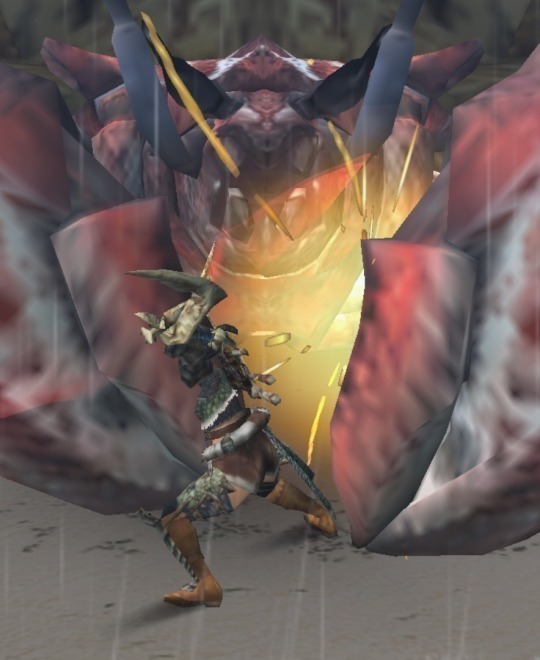
That’s one way to make fire. (Sadly it’s raining)

Hopefully the fish will still be edible tonight…
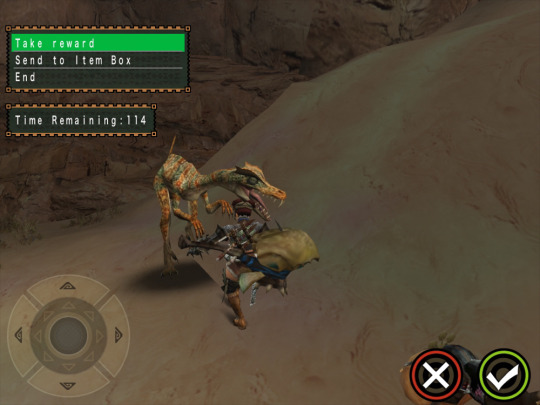
There’s no reason for you not to clear a quest with kicks, now is there?

And finally, a rare depiction of a Fairy Genprey
#long post#small hunting updates#mhfu#screenshots#that is the ios version#hermitaur daimyo#plesioth#genprey
8 notes
·
View notes
Text
Monster Hunter Rating 23: Plesioth, the Water Wyvern
Hey, guys. Sorry for not posting yesterday, but that day was stressful for a couple of reasons I’d rather not get into, and I couldn’t start writing this until close to midnight, so I decided to finish it today (which is why I’m going off the Monster List order rather than the Quest List, as an anon suggested). But don’t worry, ‘cause a shark dragon’s worth the wait. Let’s see what Plesioth has to offer!

(How it appears in Monster Hunter 1)

(How it appears in Monster Hunter Generations)
Appearance: Plesioth is an interesting take on the “shark dragon” concept; unlike Cephalos/drome, which had a clear divide between head and neck, the head of Plesioth, which is more in line with sharks like the great white, is the same width as the neck, which has the same width as most of the body. This gives Plesioth a body type closer to a fish like some kinds of koi or carp than a dragon. Speaking of carps, despite being a shark dragon, Plesioth has carp-like scales and even colors, which seems weird, but according to Wang Fu, a Chinese scholar from the Han dynasty, Chinese dragons, which influenced descriptions of dragons in Japan, had features reminiscent of several animals, including scales like those of a carp. Now, this could be a coincidence, but even if it is, it’s a pretty cool detail.
Plesioth also have a lot of spiny fins, which are similar to those of several species of bass, though the Plesioth’s have spines which extend beyond their membranes. Their wings are also modeled after these fins, but their greater size means that it’s easier to see the gradient on the membranes, which, by the way, looks really nice and complements the colors on the main body really well. I really like this design! It nails the water dragon look really well and has some nice touches that accentuate that. It’s definitely my favorite design out of all the monsters I’ve talked about so far, so y’know what? 10/10.
Behavior: Plesioth are ambush hunters that feed on both under- and above-water prey; for the latter, they prefer to wait until the landlubbers get too close to the water’s edge, just like a crocodile. Their sensitive hearing means that they’re likely to hear the footsteps of anything coming for a drink, but it also means that really loud sounds can frighten them and cause them to flail wildly. They’re territorial enough to regularly patrol their “turf,” but they also fear confrontation due to having weak defenses, and will avoid picking fights if at all possible. Once a Plesioth decides to fight, though, it can be rather persistent, even coming out of the water to attack its target.
Now, that’s not to say they’re uncomfortable on land; they may not be the apex predators that they are underwater, but they’re still a force to be reckoned with. Not many predators will try to feed on something that’s 65 feet long at its smallest and 127 feet long at its largest. Oh, yeah, did I not mention that this thing’s the largest monster I’ve talked about so far? My bad. There are larger monsters that pose a threat to Plesioth, though, which is why these wyverns never like to be far from a body of water. They have to surface at some point, though, because for some reason, they don’t have gills, meaning that they can’t breathe underwater. This a dragon that’s so devoted to an underwater life, it gave up wings that could be used to fly for wings that act as fins, and it still needs to breathe air!? Get your act together, evolution! Okay, it kinda did; they can breathe air both through their mouths and, like amphibians, through their skin, but I don’t see how considering they have scales.
Finally, I should probably point out that like real sharks, Plesioth are viviparous, meaning that they have wombs, rather than lay eggs. And also like real sharks, the babies in the womb will fight and eat each other. Ah, the majesty of nature can be so nauseating at times. The concept of a monster that’s the top of the food chain underwater and still formidable on land is pretty cool, but the fact that Plesioth can’t breathe water is ridiculous. I guess they needed an explanation for why it would ever spend time out of the water? Well, whatever the reason, it’s not like Plesioth are likely to be in danger of something attacking them when they stick their heads out to breathe, so it’s not that big of a deal. 7/10.
Abilities: Those spines aren’t for show; they contain a sleep-inducing neurotoxin that’ll put you to sleep after a single scratch. The wiki also says that Plesioth can inject the toxin through bites, but it only specifies the neurotoxin being in their fins, so I dunno what’s going on here. Speaking of biting, Plesioth have powerful jaws that can crush the armor of some monsters, such as Carapaceon, so you know that getting bit by it has got to suck. They also utilize their size for attacks such as tail swipes, hip checks, and charges. The most notable attack Plesioth have, however, is their ability to fire a stream of highly pressurized water that they previously swallowed while swimming. In real life, pressurized water is used industrially to cut and shape steel, so that tells you what kind of pain you’re in for if you get hit by that. Plus, if it’s anything like the stream fired by Mizutsune, it inflicts Waterblight, a status condition which temporarily decreases the speed at which your stamina recharges, and take it from an Insect Glaive main, that’s not fun. 8/10.
Equipment: So, several Plesioth weapons have Cephalos parts in them, and the weapons as a whole have a similar aesthetic, but they’re still distinct, at least in my opinion. Let’s start off with the Great Sword called the Finblade:

I like how the membrane has the gradient on it to show that it’s from the edge of the fin. I also like the handguard next to the handle; the curve makes it fit the water aesthetic. Next, we have a Lance called the Aqua Spear:

Hey, gotta have a trident in here somewhere, right? Having a membrane between the trident’s points and the shield’s spikes is a nice touch, and I like how the shield looks with that ring of green surrounding its core. But I gotta have a weird weapon somewhere in here, so here’s a Bow called the Dragonhead Harp:
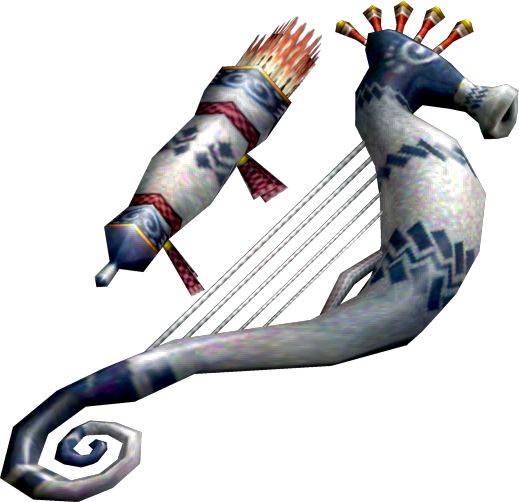
Yes, this is a Plesioth weapon. No, there are no other monster materials used in it that could say otherwise. I honestly don’t know why it looks like this, but it has the Outset Island aesthetic from LoZ: Wind Waker. It even looks like it could be a cannon for your ship in Phantom Hourglass. There is one thing linking this with Plesioth, though: the “feathers” on the arrows in the quiver are made from Plesioth fins. It’s a small detail that really brings the weapon together. As for the armor, there’s unfortunately not any pictures of normal Plesioth armor on its equipment page, and I don’t wanna scrounge around the wiki, so here’s the Gunner version of the “G” armor from MHFG:
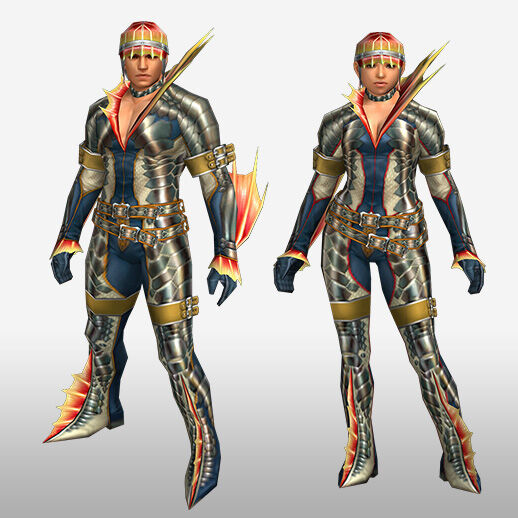
I mean, I get it; it’s a diver’s wetsuit with Plesioth fins. The problem I have with it is that there’s not much Plesioth there; the only things here that I can confirm to be from Plesioth are the fins that serve as details, not the main makeup. But there’s another armor set that...look, I had to show it, all right? It’s called the “Apukaru” armor, and while it’s made from both Plesioth and Hermitaur parts, I think there’s enough Plesioth there to warrant showing it here:

Is this armor for hunting monsters or going for a leisurely dive in the Bahamas? Okay, the diving suit the female set is based off of is most certainly not used for leisure, but you get my point, right? This is straight up diving gear made for war! The red parts match up with Hermitaur, but the fins and scales are all Plesioth, and they’ve done some really clever things with the former. First, both suits have the fin membranes as the membranes on their flippers, which is to be expected, but then you look at the female set and realize that the crown on top of the diving helmet is made of the fin membrane. That’s kinda gross, but also hilarious. Also, why is there a princess crown on top of the diving helmet!? It’s such an unnecessary detail, but it adds so much. This equipment gets a 9/10 for being both aesthetically pleasing and goofy as all get-out.
Final Thoughts and Tally: I knew I was gonna like this monster as long as they did it right, and they did it so well that it’s probably my favorite monster in the series (not that I know of many, but semantics). The little details in its design, the fact that it’s dangerous on land and king in the water, the battle prowess, the equipment, and the fact that it’s a freaking shark dragon all make Plesioth the biggest fish in the pond. I’d say that it’s probably gonna go downhill from here, but oh, don’t worry. We’ve got some special guests coming soon. 8/10.
10 notes
·
View notes
Photo

Something that popped into my mind a month or two back but only got started on in the last few weeks. After working on this for a long while I've finally gotten it done! :D
If anyone else wants to give this a shot here's the link to the full sized blank image.
A few of my friends are giving it a try too, and I'm really liking their progress so far :D
Posted on Pixiv too with individual panels at full size:
https://www.pixiv.net/en/artworks/81710328
Valstrax and Lucent are styled after my characters Victor and Ghost, and the Plesioth is a guest starring from @askplesioth / @plesioths
I tried to refrain from overlapping and duplicates, like Bird Wyvern could also be Yian Garuga except I'm already using Yian Garuga for Fav 1st-Gen. Similarly, Abyssal Lagiacrus could easily fill Fav 3rd, Leviathan, and Fav Thunder; but for Thunder?
Well, I had to make an exception there because after spending hours trying to decide I honestly couldn't settle on either Raizex or Ivory for it so I put them both in. Hate to break it to them, but they're fighting over second-place there :P
Alatreon, Shagaru, Dire Mirals, and Dalamadur all competed for Fav Elder but Alatreon is hands down my favorite themesong by far and by far, so it fell to the latter three. Eventually settled on Shagaru since he was my first ever Elder defeated back in 4G, so there's a bit of history and nostalgia there.
Lil’ Xeno's all excited that he's on the page, and is calling out to big brother Safi to tell him the news ^^
Gore's breaking the fourth wall by exploring around, and Paria by eating his own panel.
#monhun#lagiacrus#ivory lagiacrus#abyssal lagiacrus#raizex#astalos#glavenus#dinovaldo#mizutsune#great jaggi#great girros#najarala#yian garuga#garuga#kutku#tigrex#zamtrios#valstrax#vaal hazak#plesioth#agnaktor#glacial agnaktor#alatreon#xeno'jiiva
80 notes
·
View notes
Photo
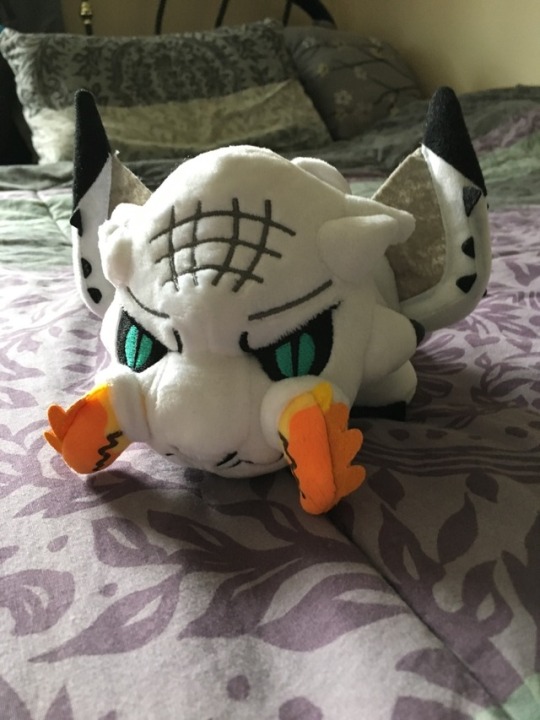
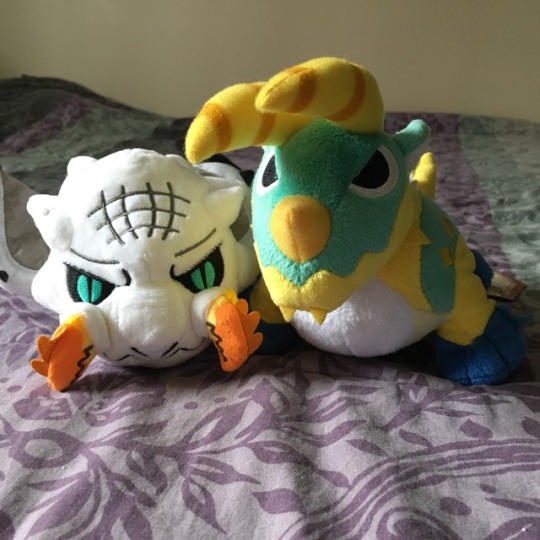

((SHE'S HERE!!!!!!))
180 notes
·
View notes
Text

plesioth mystery dungeon
#look at my boy in the top right. he deserves all the joy in the world.#plesioth posting#monster hunter#monhun#mh#pokemon mystery dungeon#pmd#my art <3
943 notes
·
View notes
Text
Guess I'll post this here for anyone who follows me and likes Monster Hunter. The Facebook reception was pretty 🦗🦗🦗

The prompt was to design a Piscine Wyvern that people would actually like. On a second pass I might change it a bit, but I like it. It's based off of fying fish and ww1 fighter planes. Color scheme would be silvery blue with countershading like a flying fish. The eye spots are black and white and are reminiscent of its own eyes.
When not enraged, feeding, or swimming all of its fins are folded in. I didn't get to that part, but Ideally it would look fairly sleek and unthreatening. Of course when it is enraged I gave it the psycho eyes and more aggressive fins, and false eyespots.
In combat its even more agile in the air than in the water, flying circles around hunters. Physical attacks include some bite combos, and leaping tackles. When enraged they transition from the leaping tackle into a nose up wings out mid-leap take-off. Its primary offensive ability is of course the good ol' Plesioth family water beam (I figured it could be a related species). It would fire them st the feet of hunters on strafing runs and dives. When its health drains as the fight runs its course it would add more and more aviation attacks to its repertoire. Barrel roll tackles, spins and twirls while firing the water beam.
Its big bang attack would involve diving into a source of water and shooting back out of it with a ton of water clinging to its body. It targets a hunter and goes in for a kamikaze dive. Before hitting the ground it shoots off a tracking beam in the direction the hunter is running. The impact creates an explosion of water that would look like a massively magnified drop of water hitting a surface from a height splash. Any hunter near enough the impact sight would be damaged and flung through the air, good luck if you get hit by it. This attack does self damage the creature, and it will be briefly vulnerable afterwards.
I don't yet have a name for it, but I figure since its more closely related to Plesioth than to Beotodus and the like, it would have a -sioth suffix.
27 notes
·
View notes
Text
Round 4 Matchups
It's finally time for the Round 4 Matchups to be announced! As the tournament goes on, fewer and fewer monsters remain; there's only 16 matches this round. In the past, I've had voting begin 1 week (give or take a few hours) after the posting of the matchups, however for future rounds that probably shouldn't be necessary, so I'm asking all of you: should future rounds start more quickly? For clarity, this round's voting will still begin on the 8th, this is just for future rounds.
As per usual, this post will be updated over time with links as the matches get posted. As always, happy voting, and may the best monster win!
Fatalis Vs. Narwa the Allmother
Royal Ludroth Vs. Dalamadur
Bazelgeuse Vs. Astalos
Tobi-Kadachi Vs. Pukei-Pukei
Dodogama Vs. Nakarkos
Plesioth Vs. Frostfang Barioth
Dah'ren Mohran Vs. Hellblade Glavenus
Jhen Mohran Vs. Namielle
Thunderlord Zinogre Vs. Seregios
Stygian Zinogre Vs. Odogaron
Espinas Vs. Glavenus
Gore Magala Vs. Nergigante
Ahtal-Ka Vs. Xeno'jiiva
Thunder Serpent Narwa Vs. Malfestio
Mizutsune Vs. Goss Harag
Chaotic Gore Magala Vs. Shagaru Magala
3 notes
·
View notes
Text
Please refer to this post for details
This list will be updated as requests come in. Reminder you can pick any number and monster from any game!
Hunter
Nergigante
Valstrax
Kushala
Xeno'jiiva
Plesioth ( requested by @keganon )
Astalos
Gammoth
Glavenus ( 7-9 requested by @scurpmun )
Mizustune
Seregios
Chaotic Gore Magala
OUR LORD GOGMAZIOS
Shah Dalamadur ( 11-14 requested by @chimaeralab )
Ebony Odogaron ( requested by @pal1947 )
Bloodbath Diablos
Bazelgeuse ( requested by @pokecraftking )
Khezu
Grimclaw Tigrex
Seltas Queen ( requested by @pokecraftking )
Raging Brachydios
Najarala
Malfestio ( 21-23 requested by @parkzarts )
Ceadeus
Odogaron ( requested by @pal1947 )
Disufiora
Tigerstripe Zamtrios ( requested by @badman-blr )
Dire Miralis
Alatreon
White Fatalis ( no other Fatalis please let's just stick with white thanks )
Safi'jiiva
12 notes
·
View notes
Link
As of posting, has entries on:
Common Rath (Rathalos & Rathian)
Lagiacrus
Desert Barroth
Mountain Barioth
White Kirin
Plesioth
Qurupeco
3 notes
·
View notes
Text
Major changes for The Hunter’s Encyclopedia.
I’ve been working on new content and updates for The Hunter’s Encyclopedia of Animals, and after three months I’m finally ready to unveil them.
First order of business:
New releases — The chapter/dossier for the plesioth (Plesichthys coxa) and its two subspecies, the green plesioth (P. c. viridis) and the oil-backed plesioth (P. c. coxa), has been released.
Content changes — Updates have been made to the glossary, etymology page, species index, and classification page to reflect the most up-to-date information.
New classifications — The following animals have been classified:
Introduced in MH: World: bazelgeuse (Fragoreptilia fervens), gajua (Palustincola ferox), legiana (Vexillala striatifoliata), paolumu (Vesica aerostatum), pteryx (Zontanopteryx metaxydendra), radobaan (Molabrea osteophila), shepherd hare (Paramustela longauriata).
Introduced in MHF2/MHFU: burst arowana (Osteoglossum autothysia).
Introduced in MH: Frontier: anorupatisu (Pristocephale glaciesecans).
All of the new and updated content can be found on the AO3 and FF versions of the Encyclopedia as well.
Second order of business:
The Encyclopedia now has its own dedicated tumblr: @teratonomy! This will be useful for anyone that’s interested in reading what I write, but doesn’t want to follow me on my main and have their dashboards inundated with the rest of the multifandom junk I post/reblog. This blog features additional info such as an FAQ, an upcoming feature list, a dossier request page, lore- and science-based trivia, and a fictional species list. In addition to posting new excerpts from the Encyclopedia I’ll be reblogging art and posts that feature MH science. If that’s your cup of tea, you might want to head on over and check it out.
Final order of business:
The Encyclopedia has its very own website: https://huntersencyclopedia.wordpress.com/. Everything on here is the same as what’s on the new blog, but, y’know, only fancier. There’s going to be more stuff added over time as I continue to update. Honestly, it just feels really good to have my own dedicated space specifically for this project. If you guys want to check it out, I'd love some feedback on it!
20 notes
·
View notes